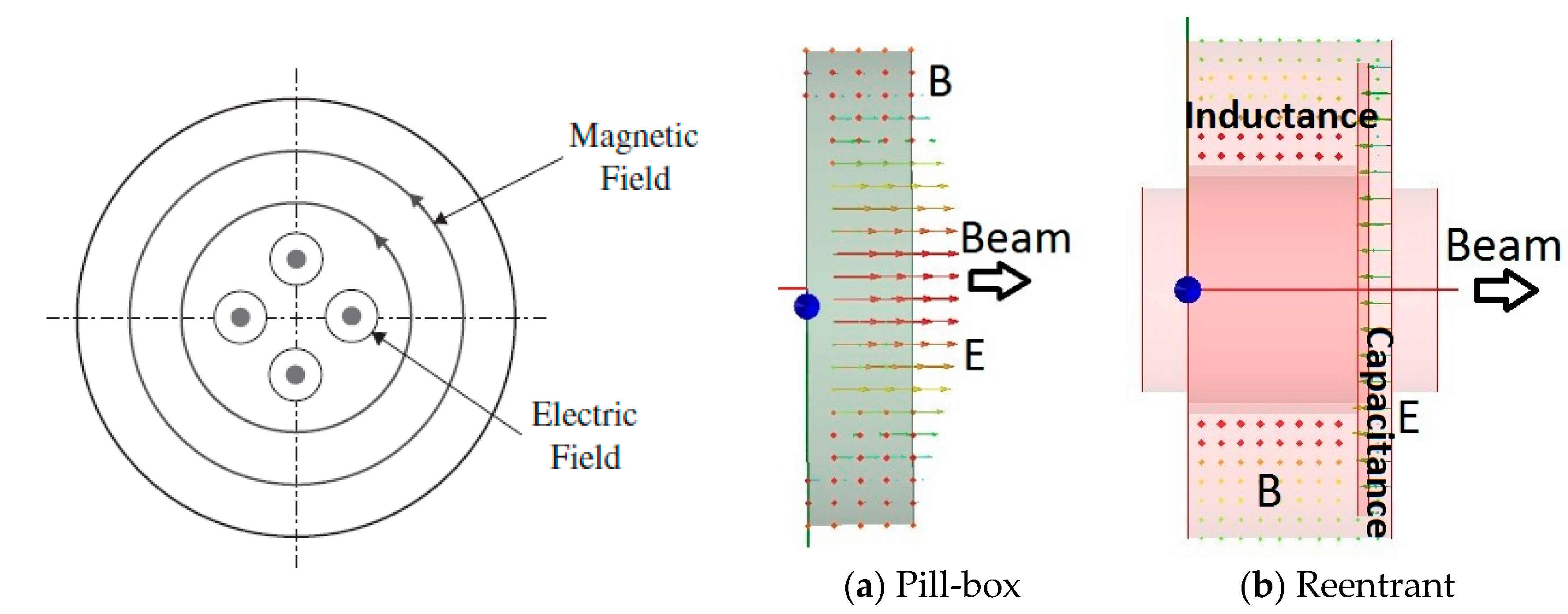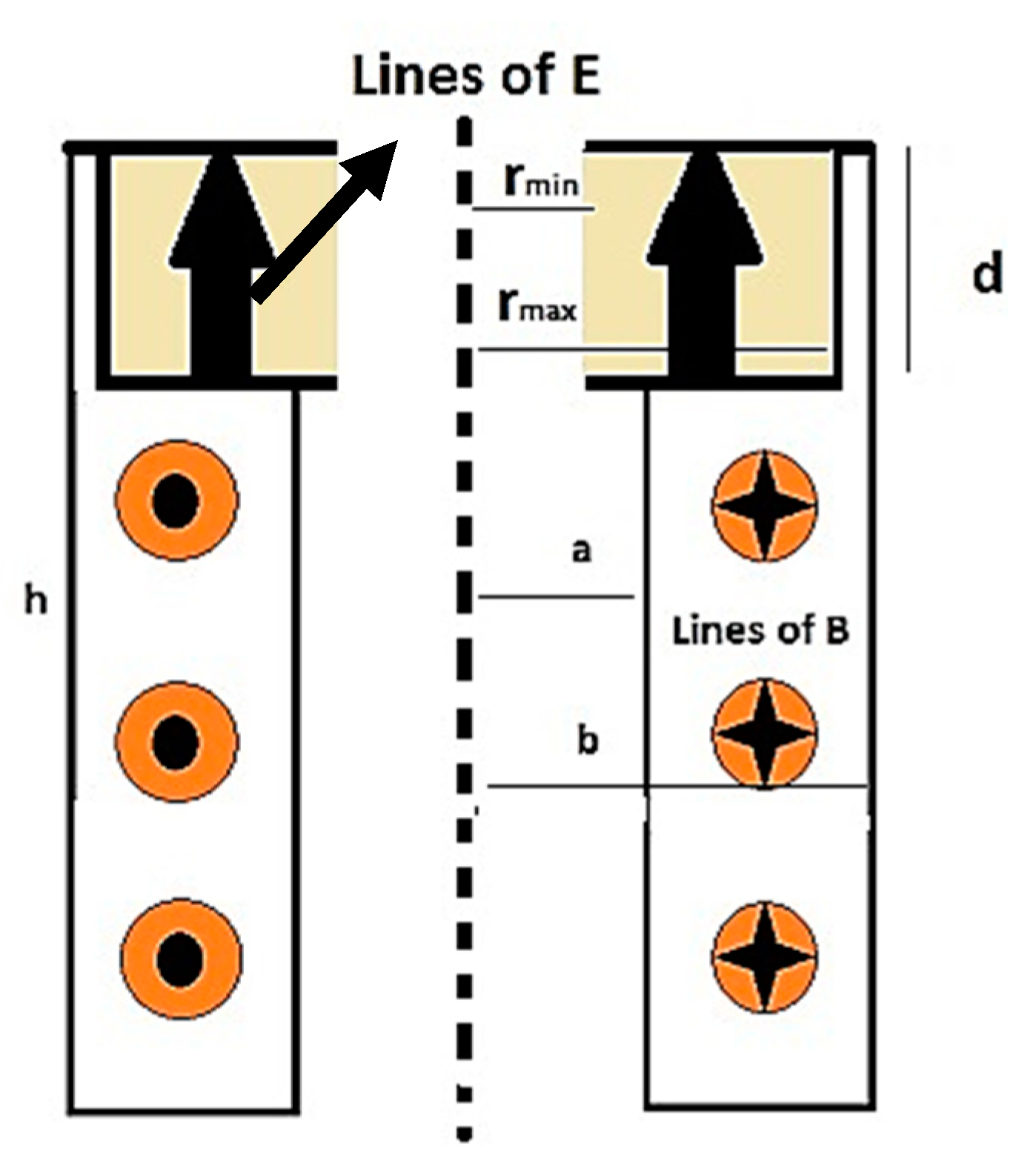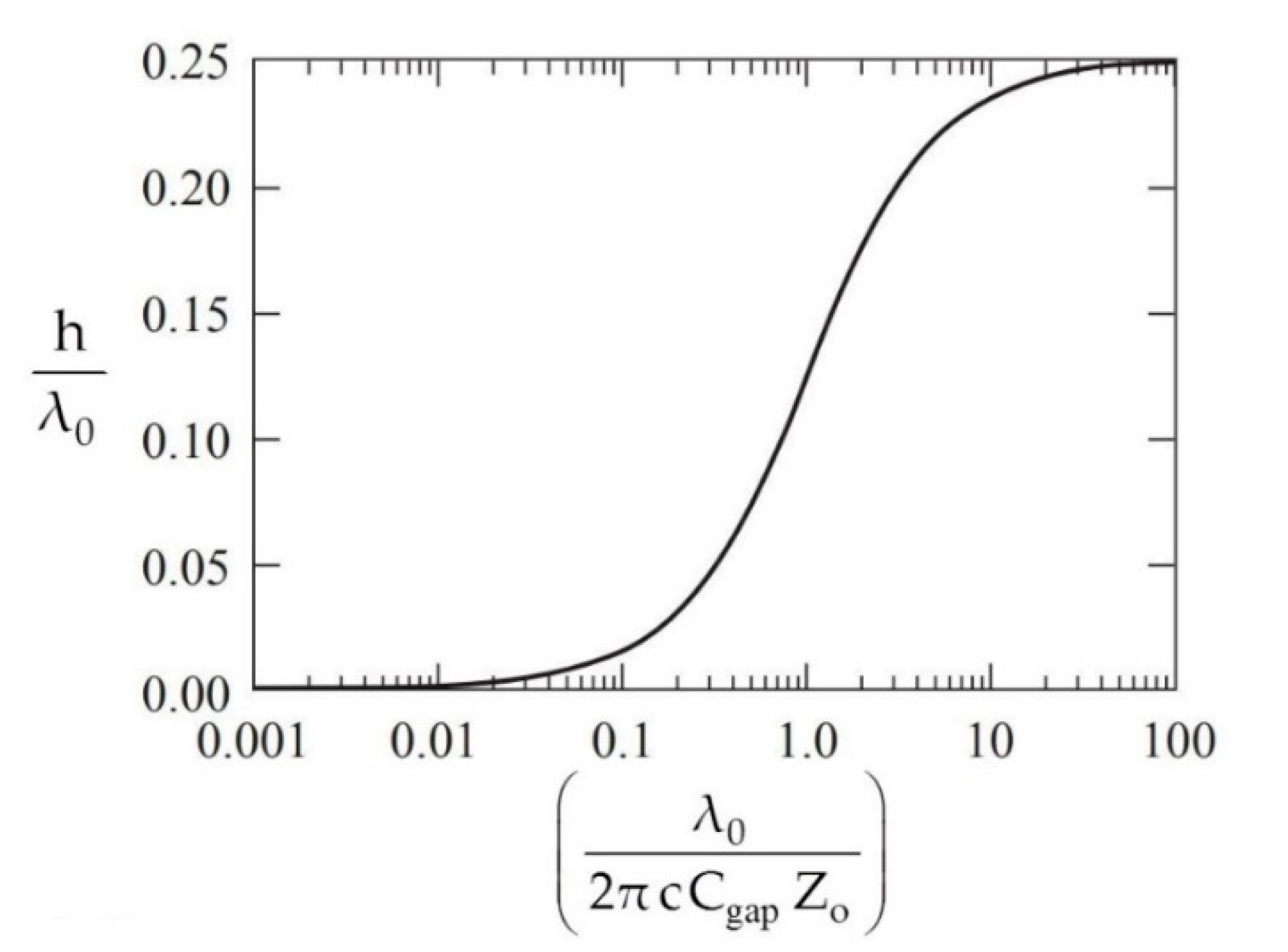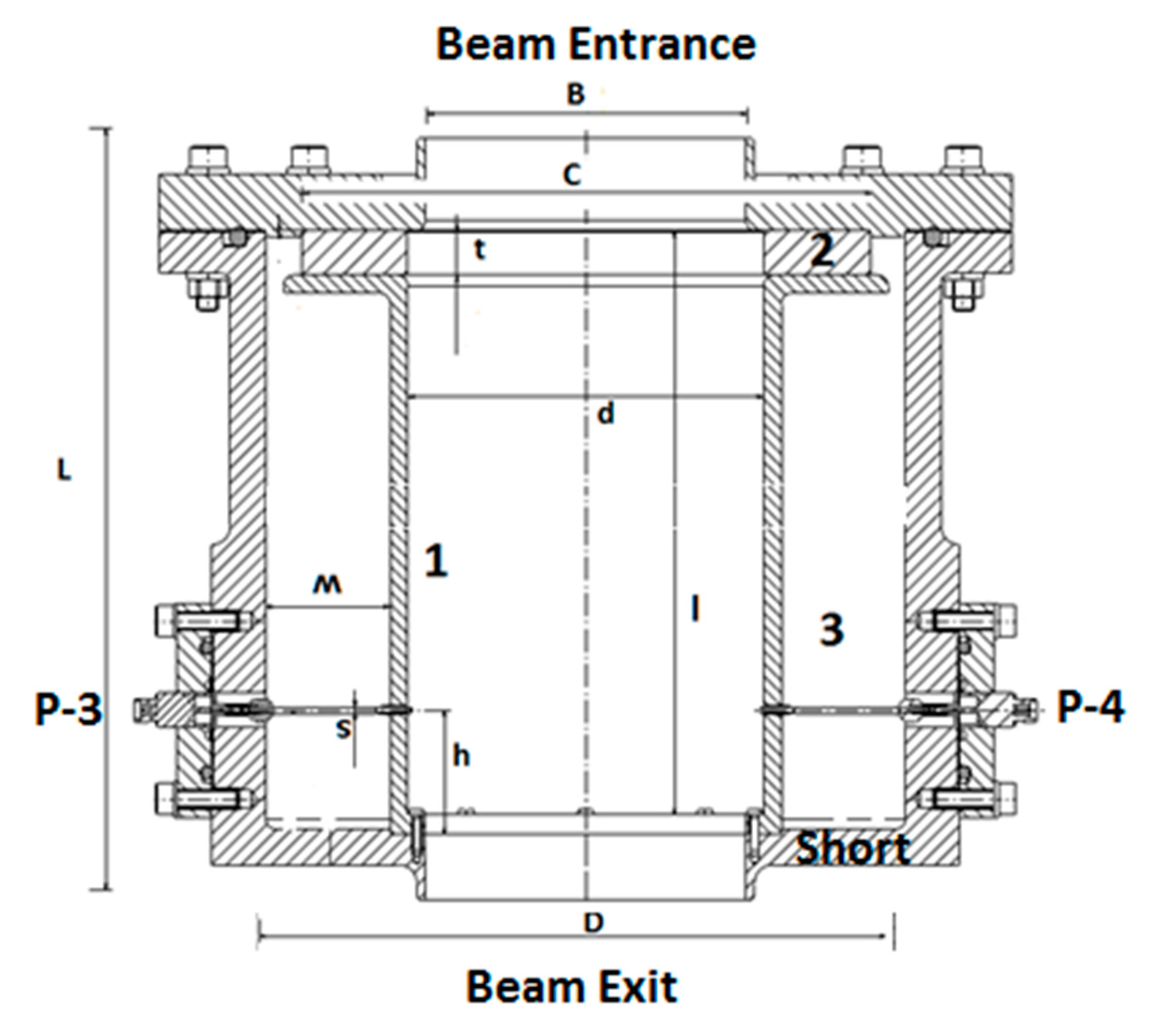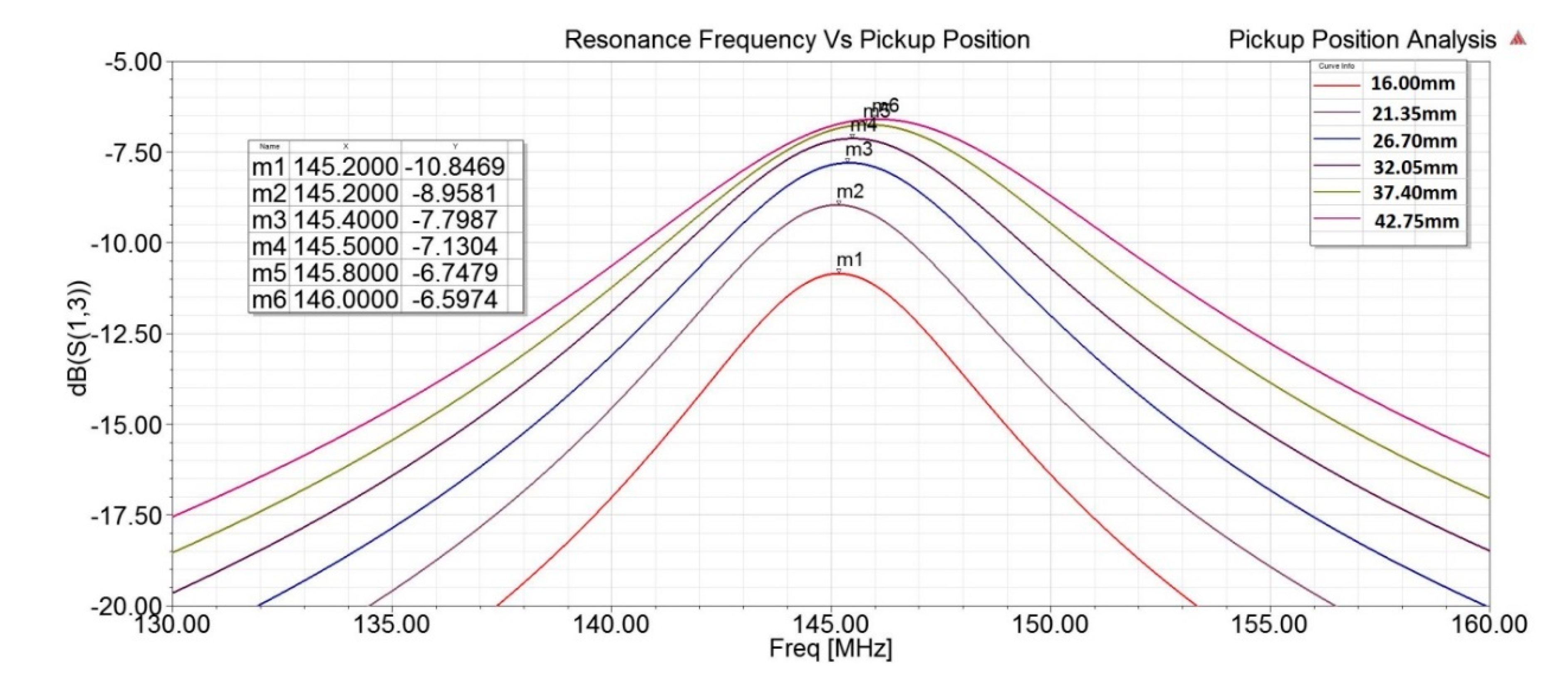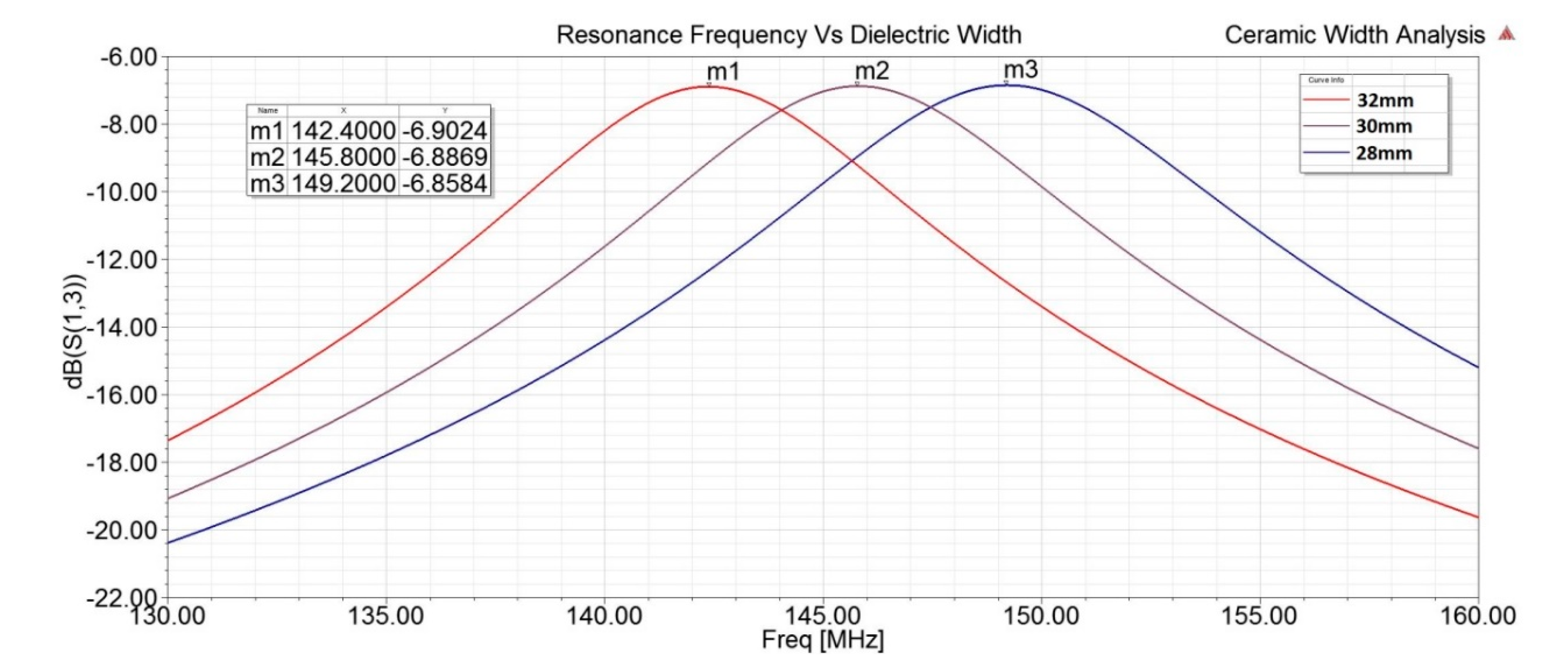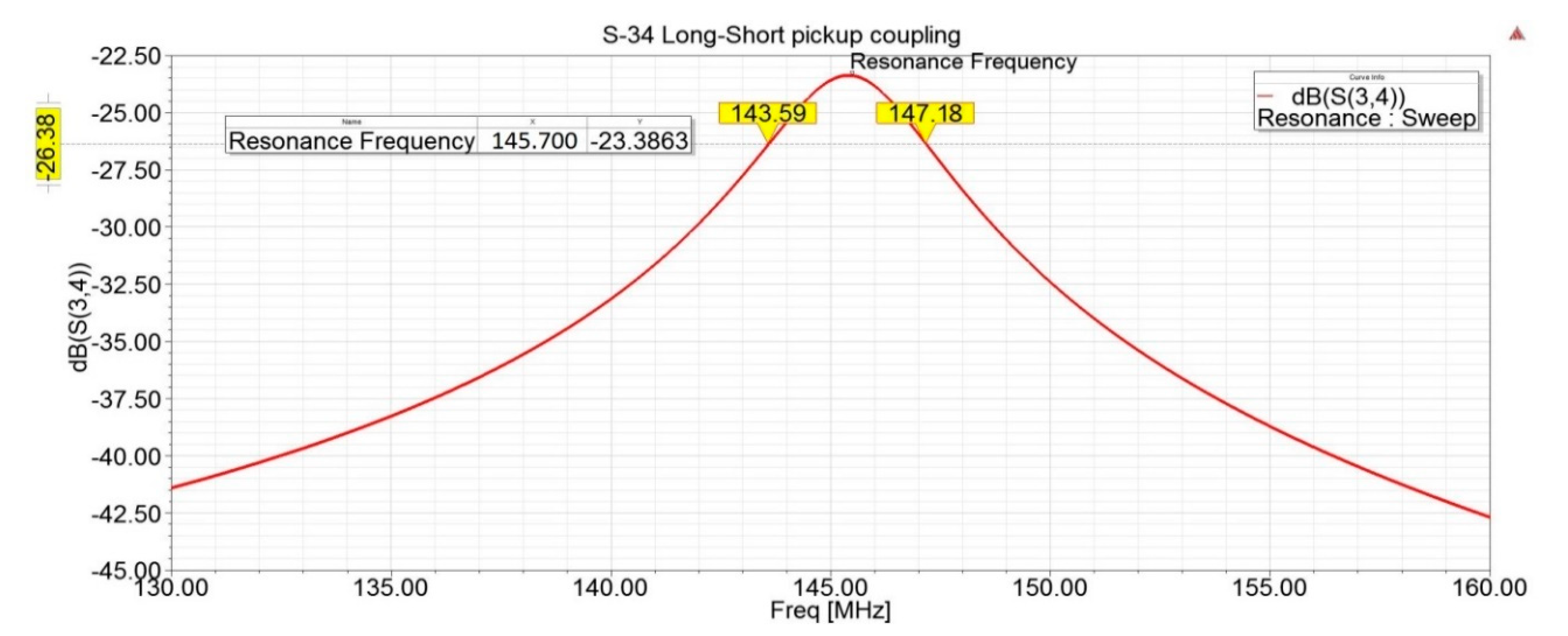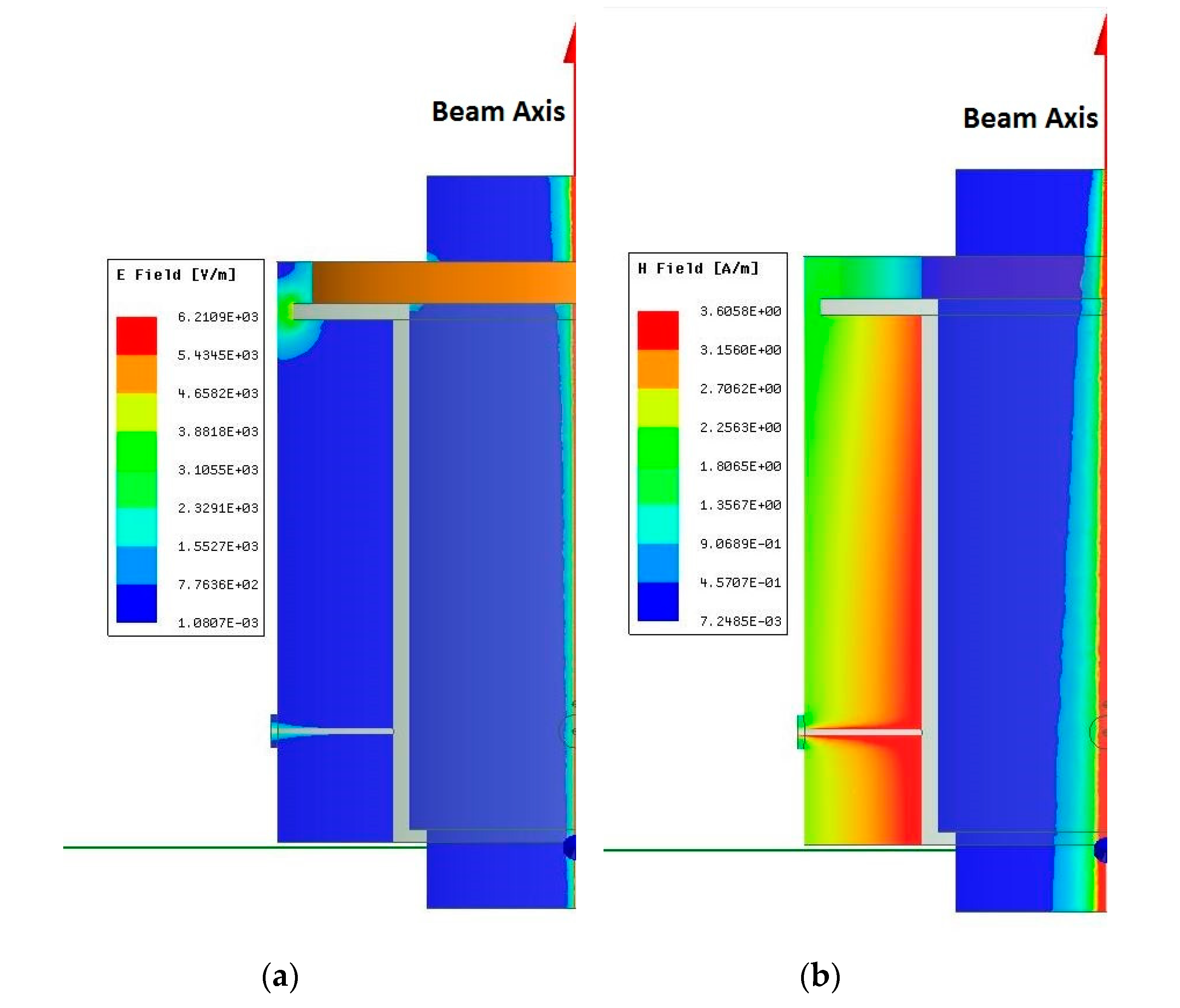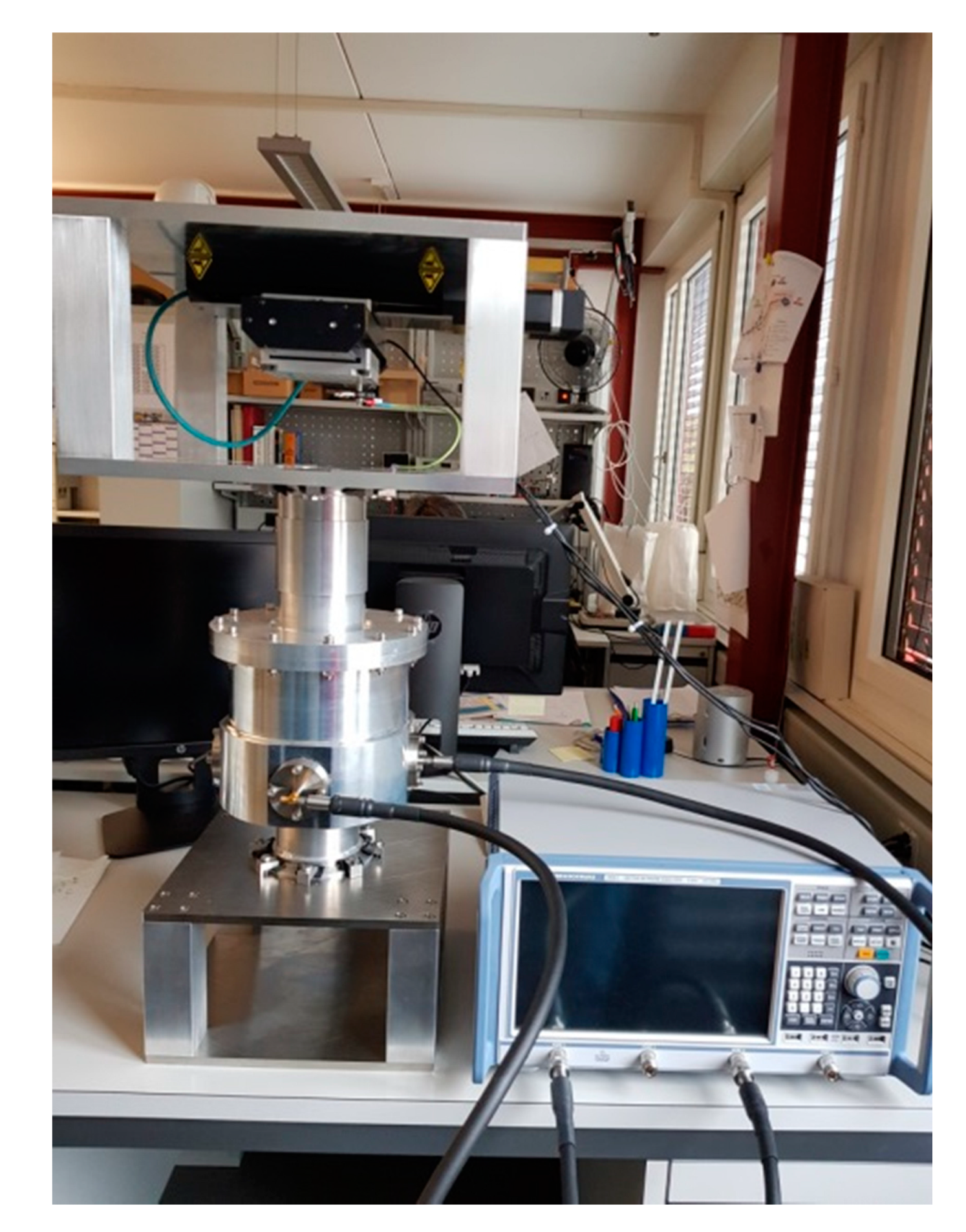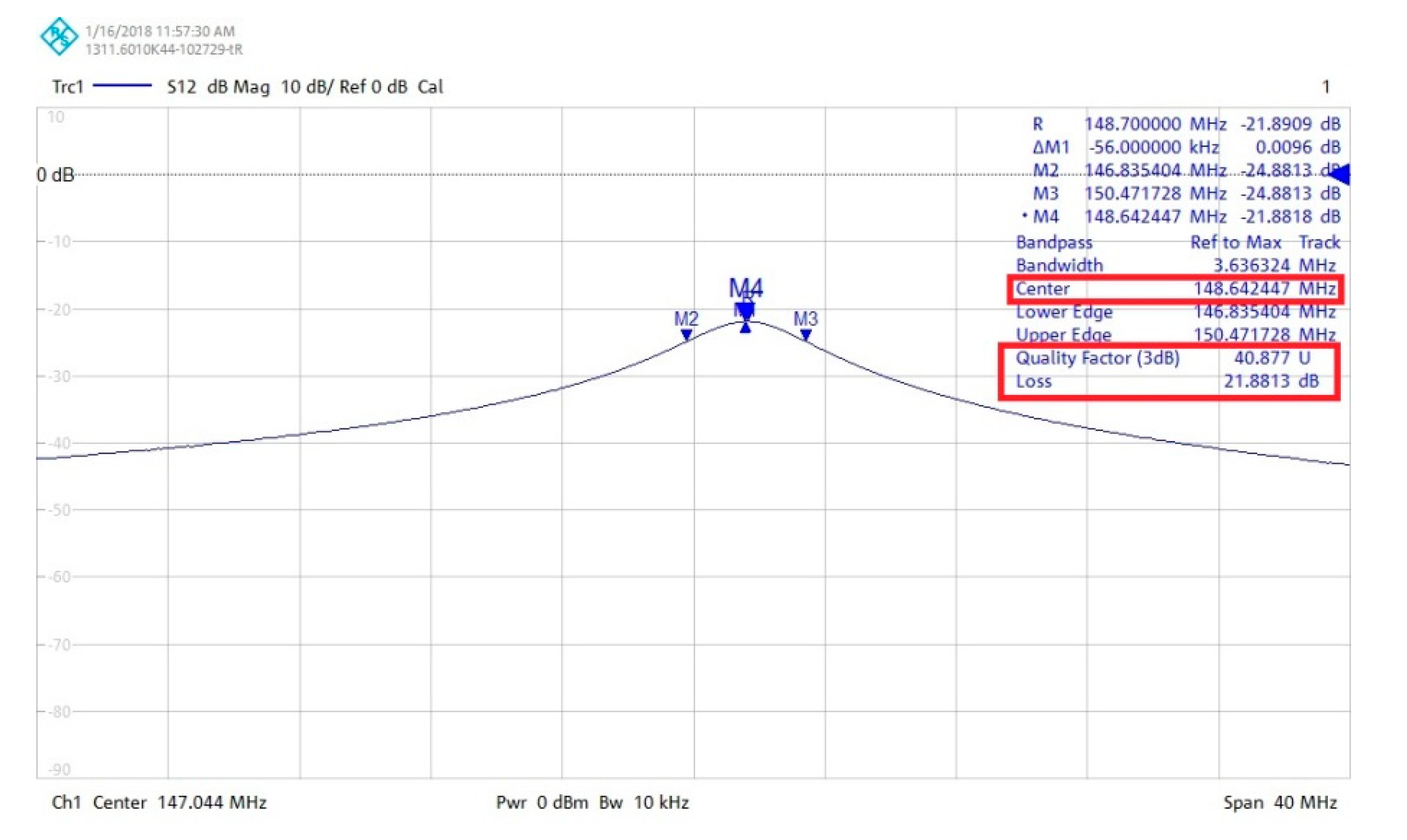1. Introduction
For any particle accelerator facility, beam diagnostics are important tools to measure beam parameters such as beam current, position, profile, emittance etc. These diagnostic devices can be classified as interceptive monitors such as the ionization chamber, Faraday cup, wire scanner, etc., and non-interceptive monitors such as the beam current transformer, wall current monitor, pick-up, etc. [
1]. A number of accelerator facilities using proton or light-ion beams [
2] are dedicated to the medical treatment of tumors. At the Paul Scherrer Institut (PSI), the PROSAN facility has been built exactly for this purpose. Its superconducting cyclotron delivers a 250 MeV [
3] proton beam. The relevant proton beam parameters are summarized in
Table 1.
At PSI, intensities of proton beam from the 590 MeV (>mA) current transformers are used. However, for beam currents of <1–1000 nA at the therapy facility, the transformers (detection threshold ≈1 μA) cannot be used. Hence, for PROSCAN, planar ionization chambers are predominantly used [
5,
6] to determine the beam current as an intercepting method [
7]. The disadvantages of these measurements are scattering issues, energy loss, and activation in the detector itself [
8,
9]. In addition, the quality of the beam delivered to patients for radiation therapy is affected by such interceptive monitors.
To mitigate the above effects, a non-interceptive monitor is envisaged to measure beam currents of low magnitude down to 0.1 nA. For such proton beam currents, the use of wall current monitors (detection threshold 100 µA) of resistive and inductive types is restricted due to their limited high frequency response caused by the short-circuiting of the ceramic gap and the necessity to employ electric shielding to prevent parasitic current flows at low frequencies into the resistor or inductor, as they are short-circuited by miscellaneous ground connections [
10]. Moreover, since they are assembled azimuthally with 10 to 100 resistors, they are also a source of thermal noise. A cryogenic current comparator with a Superconducting Quantum Interference Device (SQUID) [
10] detects extremely small magnetic fields with values in the fT to pT range [
11]. They have displayed resolution in the fraction of nA ranges. However, since they are sensitive magnetometers, coupling of the magnetic field is crucial. Also, it is necessary to provide shielding from external field contributions and a highly sensitive SQUID electronics system is essential [
12]. Consequently, they are not suited for our measurements. Non-destructive monitors of capacitive type such as button or stripline monitors, which couple to the electric field of the beam, also have limited application due to their inability to sense smaller signal levels with high resolution (measurement resolution −20 μA
rms) and their ability to deform such signals due to horizontal-vertical coupling issues [
13]. To compensate for this, the azimuthal coverage has to be increased and this results in complex mechanical realization [
9,
10].
Cavity resonators are in high demand due to their ability to measure small beam currents and their superior sensitivity compared to the other diagnostics mentioned earlier [
14]. As shown in
Figure 1, the excited fundamental resonance mode (the monopole mode) within the cavity is proportional to the beam current or to total bunch charge [
15].
The resonator governed by the outer metallic boundary allows only a discrete set of resonance frequencies with their characteristic field distribution [
16]. With a conventional pill-box cavity (
coupling), these discrete sets of resonance frequencies are separate by a few hundreds of MHz depending on the radius and length. With a reentrant cavity resonator (
coupling), the higher order modes are damped more strongly compared to the pill-box cavity [
17] by sizing the reentrant gap.
The reentrant cavity resonator designed and built at PSI is a coaxial cavity with a capacitor plane and its wall acting as a distributed inductance. The beam induced wall current (image current) excites the cavity and resonance occurs when the cavity resonance frequency matches a harmonic of the repetition frequency of the beam proton bunches. Compared to the pill-box cavity, the reentrant cavity resonator has a smaller system and it has a lower Q factor for the same resonance frequency [
18]. The compactness of the reentrant resonator is essential to save longitudinal space [
19]. It also allows simpler and precise manufacturing [
20]. A lower Q compared to the pill-box is not only acceptable but it provides less sensitivity to temperature variations that naturally occur in a non-temperature-stabilized environment.
In this paper, we present an option for measuring low proton beam currents by using a dielectric filled reentrant cavity resonator. We explain its working principle, and discuss the resonator design considerations and its advantages. Moreover, we report on the good agreement between simulation and test bench measurements of the prototype. The test bench measurement provides preliminary knowledge about the expected sensitivity and the required signal integration time of the prototype. Since the application of this diagnostic device, either as a safety device or an online monitoring is ruled by the signal integration time, this will be studied in the future with beamline measurements on the prototype.
2. Overview of Working Principle
The reentrant cavity resonator’s working principle is very similar to the high frequency resonators described in Feynman’s Lectures [
21] (
Figure 2). It can be modeled as two connected lump elements, the capacitor plates (
) and the cavity wall as the inductor (
), with a resonant angular frequency given then by:
can be estimated using the standard expression of plate capacitor:
with
and
being the outer and inner radius of the plates, and
is the gap between the two plates.
2.1. Transmission Line Analogy
An estimate of the resonator length is attained by performing the calculations within the framework of transmission line theory. This takes into account the coaxial shape of the resonator and the capacitive contribution from the wall itself.
From the expression for the inductance and capacitance of a coaxial transmission line:
where:
b: the inner radius of the outer conductor
a: the outer radius of the inner conductor
: the vacuum permittivity = 8.854 × 10−12 F/m
: the relative permittivity of the dielectric of choice
: the permeability, for the vacuum = 4 × 10−7 H/m, and
: the length of the coaxial line, i.e., the reentrant cavity resonator.
The characteristic impedance of the coaxial line can be expressed as:
Using the general expression for a lossless line, the impedance
as seen at the input of a coaxial line [
22]:
where
is the wave number,
is the length of the transmission line, j is the complex imaginary, and
is a load impedance.
In our case, in fact it is a short-circuit line, i.e., Z
L = 0, and the equation (6) can be simplified to:
Equation shows that the impedance is inductive for resonator length smaller than λ/4 as it is in the form of an inductive reactance.
Thus, in our case, the resonance is obtained at the frequency for which the gap capacitance C
gap compensates
, and replacing the angular frequency
the corresponding wave length
and
the propagation velocity:
The resonance condition then yields:
Figure 3 shows the universal tuning curve, which helps in determining the length of the resonator for a given resonance frequency normalized to the quarter-wavelength resonance. For a gap capacitance of 49.4 pF, and a coaxial characteristic impedance of 36 Ω, a free space wavelength corresponding to 2.06 m (corresponding to 145.7 MHz), h is approximately 180 mm. This corresponds to the length, i.e., the length of the inner cylinder + the thickness of the dielectric.
2.2. Q (Quality) Factor
The so-called quality factor Q is used for characterizing the bandwidth and the rate of energy loss of a resonator. It is defined as the ratio between the maximum energy stored in the resonator and the dissipated energy [
24,
25] and can be expressed as [
26]:
where:
: Maximum energy stored in the resonator
: Average dissipated power.
The losses that account for the dissipated energy may be located in the cavity itself as internal losses (non-perfectly conducting cavity wall
and lossy dielectrics
), may be due to the radiated electromagnetic field
or originate from the coupled external circuitry
(cable, external load) as external losses. The unloaded Q factor
is from the internal losses and the loaded Q factor
takes into account all the possible losses:
By assuming the radiated losses are negligible
= 0, we can simplify the above equation to:
If the cavity is used as a beam current diagnostic element, the external connection is usually 50Ω to minimize the reflections on the line. As will be shown in the simulation results, if the external quality factor, i.e., is much smaller than , it has the most effect on the loaded Q, i.e., .
When looking at the bandwidth of the resonance system, the Q factor translates to the ratio between the resonance frequency and the bandwidth at −3 dB:
2.3. Second Harmonic Matching
The fundamental resonance frequency of the reentrant cavity resonator is matched to the second harmonic of the 72.85 MHz beam bunch repetition rate to suppress the direct noise of the RF frequency. This frequency harmonic has been selected because of the expected Fourier spectrum (
Figure 4) of the pulses produced by the proton bunches. Indeed, it first contains more energy compared to higher frequency components, and it is also less dependent on the exact shape of the measured pulse signals produced by the proton bunches compared to higher harmonics. The fundamental component has been disregarded because of the direct perturbations produced by the cyclotron accelerating cavities.
The measurements were performed at one frequency, i.e., 145.7 MHz, to deliver a signal that is proportional to the beam current. By assuming, for the sake of simplification, a square pulse for the proton bunch shape, the various Fourier components X
n of the signal are directly proportional to the beam current itself [
27]:
where
A is the amplitude of the beam pulse, Δ is the beam pulse length,
T is the period of the repetition rate,
n is the harmonic. Since the product
AΔ is proportional to the charges contained in 1 pulse,
AΔ/
T is proportional to the beam current.
4. Test Bench Characterization
The prototype is characterized in a standalone test bench as shown in
Figure 11 [
31].
The components of the test bench are: a pair of linear drives from Newport (FCL100) configured as XY; Rhode & Schwarz ZNB8 network analyzer and the device under test (DUT), i.e., the resonator prototype. To characterize the reentrant cavity resonator, network analysis measurement was performed in the absence of a beam analogon. S34, the S-coupling between a long pickup (port 3) and a small pickup (port 4) is shown in
Figure 12.
Table 3 summarizes the measured S-coupling parameter between all pickup combinations, resonance frequency and Q factor.
The measurement is done in the absence of a stretched wire to analyze the performance of the stand-alone resonator. The resonance frequency is the peak frequency and the Q factor represents the performance of the resonator. As described in
Section 2, the Q factor is a measure of both internal and external losses that is associated with the resonator. This takes into account the lossy dielectrics, imperfect conducting cavity walls, radiated electromagnetic field or external coupling. The 50 Ω external loads that were connected to the pickups represent the main losses and explain the relatively low Q values. S-peak values are slightly larger than those calculated with ANSYS. One reason for this may be the difference between simulated and actual small pickup loops as the measured S-coupling associated with any small pickup loop is different from the simulated S-coupling, with the only exception, the large pickup combination (S-35) being very close to the expected value. Variations in the resonance frequency, S-peak and Q-factor measured values are indicative of the mechanical precision that can be obtained with our prototype and experimental set-up. From the measurements, it could be confirmed that the prototype worked as expected and was in good agreement with the simulation results.
5. Discussion
The comparison between the simulation and measurement of S-34 between a long and a small pickup is summarized in
Figure 13 and
Table 3. The measured Q value is in good agreement with the simulated value. However, the measured resonance frequency is approximately 2% higher than the simulated (design) resonance frequency.
This discrepancy is attributed to the assumption that the Macor ceramic dielectric constant is frequency dependent. In the simulation, the Macor ceramic was assigned a dielectric constant of 6.0 whereas from the measurement, it is evaluated as 5.7, which corresponds to higher frequency of operation. By changing the dielectric constant to 5.7 in the simulation, the simulated resonance frequency matched the measured resonance frequency within a few hundreds of kHz tolerance, as shown in
Figure 13. As a consequence, the Macor ceramic’s dimension had to be changed to match the desired resonance frequency of 145.7 MHz. With the help of HFSS simulation, a new Macor ceramic ring of 33 mm width with the same thickness was manufactured and it will be placed in the prototype before testing it on the beamline for final characterization.
Since the test bench results confirmed the HFSS simulations, the expected sensitivity of the system can also be calculated with good confidence. For a given power excitation, the current across the beam entrance and the induced voltage on the pickups can be calculated. For a pickup terminated with an impedance of 50 Ω, the pickup voltage is summarized in
Table 4.
This corresponds to the 2nd beam harmonic at 145.7 MHz. For a beam bunch repetition rate of 72.85 MHz, with a pulse length of 2 ns, the frequency spectrum could be calculated using Equation (13). For the second harmonic, the amplitude is approximately 25% of the beam current. Hence, for a beam current of 1 nA, the current at the second harmonic is about 0.25 nA, the pickup amplitude is approximately 15nV (
Table 4) and the power ratio is −143 dBm. To read such low signals from the resonator would demand for amplification and high-end ADCs. Assuming a noise contribution of 4dB from the measurement chain, and a signal integration time of 1 second, the expected noise floor is −170 dBm (−174 + 4 dBm), i.e., 0.7 nV. Therefore, the signal-to-noise ratio (SNR) for the prototype can be expected to be around 27.
Since the resonator will be placed beyond the degrader, calibration is important since this is based on its location. Since the velocity spectrum is not monochromatic, some particles in the bunch will be slightly faster and others will be slower than the average bunch velocity. As a consequence, the proton bunch length will increase along the beam line. This is especially true for lower proton beam energy (70 MeV), at which the degrader produces a higher energy spread compared to non-degraded beam. The power spectrum will vary accordingly, affecting the 2nd harmonic amplitude. The second harmonic amplitude is then decreased as Δ increases, i.e., the bunch length is stretched as in Equation (13). This consequently reduces the sensitivity of the reentrant cavity resonator. Due to this dependence of the resonator response, its location should be chosen at a short distance from the degrader.
6. Conclusions
A reentrant cavity resonator was built to measure low proton beam currents in a non-interceptive way. Its design was achieved using the ANSYS simulation tool and the resonance frequency was tuned to match the second harmonic of the beam pulse repetition rate of 72.85 MHz; also, the position of the pickups in the resonator was optimized.
A stand-alone test bench was used to characterize the resonator according to network analysis measurements, which yielded S-parameter coupling between the different pickups. The Q factor is in good agreement with the simulated value. It could be observed that the measured resonance frequency was approximately 2% higher than the simulated (design) resonance frequency, which can be explained by the complex permittivity of the Macor in the resonator.
We conclude that our reentrant cavity resonator is a promising candidate for measuring low proton beam currents in a non-destructive manner. The resonator could replace interceptive monitors, such as ionization chambers to mitigate the associated problems. Moreover, the device can be constructed easily with high precision due to its simple design and radial symmetry. Hence, after mechanical modifications of the PSI PROSCAN beam lines, the reentrant cavity resonator will be validated for ongoing use within the beam line.




